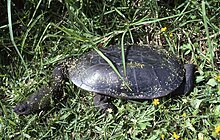
Chelidae is one of three living families of the turtle suborder Pleurodira, and are commonly called Austro-South American side-neck turtles. The family is distributed in Australia, New Guinea, parts of Indonesia, and throughout most of South America. It is a large family of turtles with a significant fossil history dating back to the Cretaceous. The family is entirely Gondwanan in origin, with no members found outside Gondwana, either in the present day or as a fossil.

The eastern long-necked turtle is an east Australian species of snake-necked turtle that inhabits a wide variety of water bodies and is an opportunistic feeder. It is a side-necked turtle (Pleurodira), meaning that it bends its head sideways into its shell rather than pulling it directly back.

Chelodina, collectively known as snake-necked turtles, is a large and diverse genus of long-necked chelid turtles with a complicated nomenclatural history. Although in the past, Macrochelodina and Macrodiremys have been considered separate genera and prior to that all the same, they are now considered subgenera of the Chelodina, further Macrochelodina and Macrodiremys are now known to apply to the same species, hence Chelydera is used for the northern snake-necked turtles.
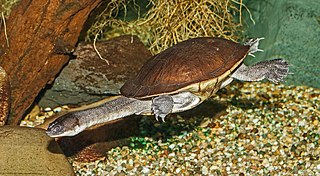
The Roti Island snake-necked turtle, also commonly known as McCord's snakeneck turtle, is a critically endangered turtle species. It is named after Rote Island in Indonesia where it was first discovered. Some individuals were later discovered in East Timor, and are considered a distinct subspecies.

The western swamp turtle or western swamp tortoise is a critically endangered species of freshwater turtle endemic to a small portion of Western Australia. It is the only member of the genus Pseudemydura in the monotypic subfamily Pseudemydurinae.

The New Guinea snake-necked turtle is a species of turtle in the family Chelidae. The species is found almost exclusively within Western Province, Papua New Guinea.

Parker's snake-necked turtle is a species of turtle in the family Chelidae.
Pritchard's snake-necked turtle is a species of turtles in the family Chelidae. The species is endemic to a restricted area of Central Province, Papua New Guinea.
Reimann's snake-necked turtle is a species of turtle in the family Chelidae. The species is endemic to Oceania and Southeast Asia.

The northern snake-necked turtle or northern long-necked turtle is a species of turtle in the family Chelidae or Austro-South American Side-necked Turtles. It is native to northern Australia and southern New Guinea.
The Namoi River snapping turtle, also commonly known as Bell's turtle, the Namoi River elseya, or Bell's saw-shelled turtle, is a species of turtle in the family Chelidae. The species is endemic to New South Wales, Australia.

Emydura, the Australian short-necked turtles, are a genus of turtles in the family Chelidae. It was paraphyletic with Elseya. Consequently, it was split into two genera Myuchelys and Elseya by Thomson & Georges, 2009. They can grow quite large, 30 cm or more is not unusual and have a life span of around 20–30 years. They generally do not hibernate as their warmer climate lets them remain active all year round; they also spend more time in the water than other varieties. They are considered omnivore but rely on a constant supply of meat to remain healthy, feeding on basically anything that will fit into their mouth.
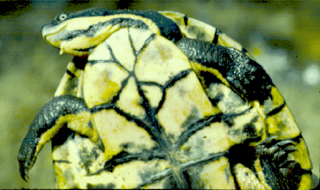
The Myuchelys is a genus of turtles, the Australian saw-shelled turtles, in the family Chelidae and subfamily Chelodininae. They inhabit the headwaters and tributaries of rivers within their range and this led to the name Myuchelys, which is formed from the Aboriginal word myuna meaning clear water and the Greek chelys meaning turtle. They have a short neck and the intergular scute completely separates the gular scutes. They have no alveolar ridge separating them from the snapping turtles of the genus Elseya.
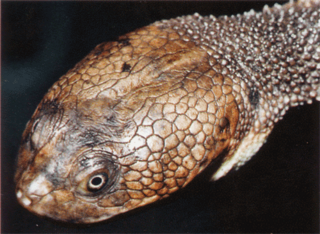
Chelodina canni, also known commonly as Cann's snake-necked turtle, is a species of turtle in the family Chelidae. The species is endemic to Australia, where it is found in the northern and northeastern parts of the continent. It has a narrow zone of hybridization with its related species the eastern snake-necked turtle, C. longicollis. For many years C. canni was assumed to be the same species as C. novaeguineae from New Guinea. However, in 2002 it was shown that these two species differ both morphologically and genetically, and therefore C. canni was separated and described as a unique species.

Chelodina (Chelydera) burrungandjii, the sandstone snake-necked turtle or Arnhem Land long-necked turtle, is a medium-sized turtle reaching carapace lengths of 316 mm. The species is found in the sandstone plateaus and escarpments and the plunge pools of Arnhem Land of the Northern Territory. The species had been long recognised as valid. However, it had been difficult to research due to the remoteness of its habitat. Efforts to breed this species in captivity had been largely unsuccessful, until National Aquarium Herpetologist Matthew Benedict lead a successful breeding project in 2021. The species occurs in proximity to Chelodina rugosa, to which it is closely related. For the most part the two species are parapatric in distribution. However, they do come together in limited locations such as plunge pools at the base of the escarpments. In these areas there is hybridization between the species.

Emydura victoriae, also known commonly as the red-faced turtle, Victoria short-necked turtle and Victoria River turtle, is a species of medium-sized aquatic turtle in the family Chelidae. The species inhabits rivers, streams and permanent water bodies across much of northern Australia.
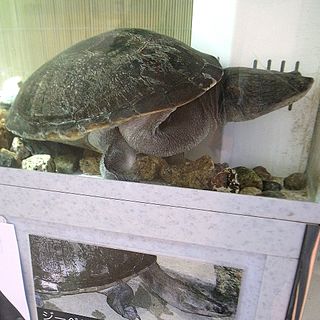
Chelodina (Chelydera) kuchlingi, commonly known as Kuchling's long-necked turtle or Kuchling's turtle, is a species of freshwater turtle in the family Chelidae. The species is endemic to Australia.
Chelodina (Chelydera) walloyarrina, the Kimberley long neck turtle or Kimberley snake-necked turtle, is a large species of long neck turtle endemic to the Kimberley region of Western Australia. In recent years, it has been unclear as to whether this was a valid species or not. It has been recognised as such by the 2017 and 2021 editions of the Turtle Checklist. In a recent paper it waslisted as a subspecies of Chelodina burrungandjii by Kehlmaier et al. 2019, however, that publication did not actually assess the type of the species nore did it analyse it. Hence it should be considered a full species.

Scott A. Thomson is an Australian herpetologist, paleontologist, and taxonomist, specialising in turtles of the family Chelidae.
Chelodina gunaleni or Gunalen's snake-necked turtle is a turtle species in the family Chelidae. The species is endemic to the lowlands of west-central West Papua, Indonesia, south of the central ranges.
